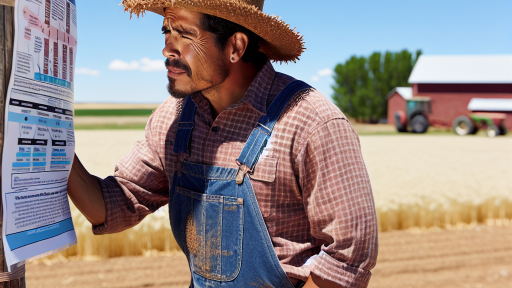Overview of Financial Assistance for New Farmers
Importance of Financial Assistance
Financial assistance is crucial for new farmers starting their ventures.
It helps them cover initial costs and manage operations effectively.
Moreover, access to funding reduces financial risk during uncertain times.
This support fosters innovation and sustainable practices in agriculture.
Types of Financial Assistance Available
Various financial assistance programs exist to aid new farmers.
These include grants, loans, and technical assistance programs.
Understanding the distinction between these options is essential.
Each type serves a different purpose and has unique eligibility requirements.
Grant Programs
Grants provide funds that do not need to be repaid.
Many government agencies and non-profit organizations offer grants.
They fund specific projects, such as environmental conservation efforts.
New farmers should research available grants in their area.
Loan Programs
Loans are another significant resource for new farmers.
The U.S. Department of Agriculture (USDA) offers various loan options.
Loan programs typically have lower interest rates than conventional loans.
Transform Your Agribusiness
Unlock your farm's potential with expert advice tailored to your needs. Get actionable steps that drive real results.
Get StartedFlexible repayment terms can ease financial burden during early years.
Technical Assistance Programs
Technical assistance programs provide guidance alongside financial support.
These programs often include workshops and training sessions.
New farmers can learn best practices and improve business skills.
Experts can also help with crop selection and resource management.
How to Access These Resources
Accessing financial assistance requires careful research and planning.
Many resources can be found online through government websites.
Local agricultural extension offices often provide valuable information.
Networking with other farmers can uncover hidden opportunities.
Preparing Applications
Application processes for financial assistance vary widely.
New farmers should prepare necessary documents well in advance.
A detailed business plan can strengthen their applications.
It should outline goals, budgets, and projected growth plans.
Seeking Guidance
Seeking guidance from experienced farmers can be beneficial.
Mentorship programs connect new farmers with seasoned professionals.
These mentors can provide insights into the application process.
Additionally, they can help identify suitable financial resources.
Types of Financial Assistance Programs Available
Government Grants
Government grants offer crucial financial support for new farmers.
These grants often do not require repayment, making them attractive options.
For instance, the U.S. Department of Agriculture (USDA) provides various grants.
Programs like the Specialty Crop Block Grant Program can help farmers access necessary resources.
Additionally, state programs may offer grants tailored to local needs.
Low-Interest Loans
Low-interest loans facilitate the purchase of equipment and land.
The USDA’s Farm Service Agency (FSA) provides these loans to qualifying farmers.
Showcase Your Farming Business
Publish your professional farming services profile on our blog for a one-time fee of $200 and reach a dedicated audience of farmers and agribusiness owners.
Publish Your ProfileThese loans feature competitive interest rates that ease repayment concerns.
Moreover, repayment terms are often flexible to accommodate farmers’ needs.
Microfinance Options
Microfinance programs cater to small-scale farmers in need of quick funding.
These programs typically provide smaller loan amounts to promote sustainability.
Organizations like Kiva allow farmers to connect with lenders globally.
This direct funding approach empowers farmers while promoting community investment.
Community Development Financial Institutions (CDFIs)
CDFIs specialize in helping underserved communities, including new farmers.
These institutions provide access to affordable capital and tailored services.
Many CDFIs focus on supporting sustainable agricultural practices.
They understand the challenges faced by new farmers and provide guidance.
Private Sector Grants
Many businesses offer grants or funding for agricultural initiatives.
Companies often seek to improve community relations or fulfill corporate social responsibility.
An example includes the Patagonia Environmental Grants Program.
Such grants can help new farmers adopt sustainable practices.
Education and Training Programs
Some financial assistance programs support educational endeavors.
These programs help farmers build skills and knowledge platforms.
The Future Farmers of America (FFA) offers various funding sources for training.
Furthermore, universities may provide grants for research projects that benefit local agriculture.
Networking and Support Groups
Support networks are essential for new farmers seeking financial assistance.
Organizations like the National Young Farmers Coalition offer both guidance and resources.
These networks can help farmers understand available programs and how to apply.
Moreover, they foster a sense of community among farmers.
Government Grants: Eligibility and Application Process
Understanding Eligibility Requirements
Government grants for new farmers often have specific eligibility requirements.
Applicants typically must show proof of their farming business.
Additionally, individuals may need to demonstrate financial need.
These grants often target farmers from underserved communities.
Furthermore, applicants usually must be within a certain age range.
Lastly, many grants ask for previous agricultural experience.
Common Types of Grants Available
Numerous grants are designed to assist new farmers.
The USDA offers programs specifically for young and beginning farmers.
Moreover, various state governments provide their own grant opportunities.
Non-profit organizations also fund agricultural initiatives.
Sustainable farming projects may attract grant funding as well.
Navigating the Application Process
The application process can seem daunting, but it can be manageable.
Start by thoroughly reviewing the grant’s eligibility criteria.
Gather all necessary documentation before starting the application.
This often includes your business plan, financial statements, and personal identification.
Next, fill out the application form carefully to avoid errors.
Submitting the application early may help to ensure consideration.
Tips for a Successful Application
Writing a compelling grant proposal can significantly increase your chances of approval.
Showcase Your Farming Business
Publish your professional farming services profile on our blog for a one-time fee of $200 and reach a dedicated audience of farmers and agribusiness owners.
Publish Your ProfileBegin with a clear, concise overview of your farming business.
Clearly articulate how the grant funds will benefit your agricultural project.
Highlight your unique selling points, such as innovative techniques or sustainability practices.
Finally, proofread your application and consult others for feedback.
Explore Further: Common Mistakes When Applying for Farm Aid
Loans for New Farmers: Understanding Terms and Conditions
Overview of Loan Options
New farmers can access various loan options to boost their operations.
The U.S. Department of Agriculture (USDA) offers direct and guaranteed loans.
These loans support purchasing land, equipment, and livestock.
Additionally, many local banks provide agricultural loans tailored for farmers.
Types of Loans
Farm Ownership Loans help new farmers buy farmland.
Operating Loans assist with the purchase of supplies and equipment.
Microloans cater specifically to small-scale farming operations.
Each type serves different financial needs in the farming community.
Understanding Loan Terms
Loan terms can vary significantly based on the lender.
Interest rates depend on the loan type and borrower’s credit history.
Some loans offer flexible repayment schedules to accommodate seasonal incomes.
Borrowers must read the fine print for specific terms and conditions.
Eligibility Criteria
Eligibility for loans often requires proof of farming experience.
Applicants must demonstrate a solid business plan for their farms.
Many lenders also consider credit scores for loan approvals.
New farmers should prepare all necessary documentation before applying.
Application Process
The loan application process often involves several steps.
First, gather all relevant financial and personal information.
Then, complete each lender’s application form accurately.
After submitting the application, be prepared for follow-up questions.
Resources for Further Assistance
New farmers can find valuable information through USDA offices.
Financial advisors specializing in agriculture can offer guidance.
Local agricultural colleges often have resources and workshops available.
Networking with other farmers can also provide insights and tips.
Delve into the Subject: Navigating Grants and Loans for Farmers
State-Specific Financial Resources and Programs
Understanding State Programs
Each state offers unique financial resources for new farmers.
These programs address specific agricultural needs.
Moreover, they often include grants, loans, and technical assistance.
California Financial Programs
California provides several programs aimed at supporting farmers.
The California Department of Food and Agriculture offers funding opportunities.
Moreover, the California Agricultural Microenterprise Program supports small farms.
- Grants for sustainable farming practices.
- Loans for buying equipment and supplies.
- Workshops on resource management.
Texas Agricultural Resources
Texas features a range of resources tailored for new farmers.
The Texas Department of Agriculture runs various grant and loan programs.
Additionally, local co-ops often provide support services.
- Access to low-interest loans.
- Financial education workshops.
- Networking opportunities with seasoned farmers.
Florida Funding Sources
Florida offers diverse financial resources to assist farmers.
Showcase Your Farming Business
Publish your professional farming services profile on our blog for a one-time fee of $200 and reach a dedicated audience of farmers and agribusiness owners.
Publish Your ProfileThe Florida Department of Agriculture and Consumer Services administers multiple programs.
These programs focus on both traditional and organic farming sectors.
- Grants for pest management.
- Support for water conservation efforts.
- Training programs on innovative farming techniques.
Midwest Financial Avenues
Many Midwest states provide specialized funding for agriculture.
State-specific programs help farmers access needed capital.
For example, the Wisconsin Fresh Food Financing Initiative supports local farmers.
- Loans for equipment renovation.
- Grants for expanding market reach.
- Support for farm-to-table initiatives.
Northeast Resource Options
The Northeast region has several programs for new farmers.
States like New York offer grants designed for young and beginning farmers.
Additionally, programs often focus on sustainable practices.
- Funding for organic certification.
- Technical assistance for crop diversification.
- Training on food safety regulations.
Finding Local Resources
Farmers should explore local agricultural extension offices.
These offices can provide detailed information on state programs.
Moreover, local universities often support farming initiatives.
Networking with other farmers can uncover hidden resources.
In addition, online databases list financial assistance programs by state.
See Related Content: Benefits of Government Aid for Farmers

Nonprofit Organizations and Their Role in Supporting New Farmers
Importance of Nonprofit Support
Nonprofit organizations play a crucial role in supporting new farmers.
They provide essential resources and expertise to budding agriculturalists.
Furthermore, they assist in connecting farmers with funding opportunities.
Many nonprofits focus on education, outreach, and advocacy.
Types of Support Offered
Nonprofits offer various forms of assistance to new farmers.
Financial aid is often a primary benefit available through these organizations.
Training programs help build essential skills for successful farming.
Networking events facilitate connections with other farmers and industry experts.
Financial Assistance
Many nonprofits provide grants and loans tailored for new farmers.
For instance, the Green Farm Initiative offers low-interest loans.
Similarly, the Harvest Fund provides grants for sustainable farming practices.
Education and Training
Numerous nonprofit organizations host workshops and seminars.
These events cover a wide range of farming topics.
Some organizations even offer online courses for greater accessibility.
Community Engagement
Engagement in community-driven initiatives fosters collaboration among farmers.
Nonprofits often encourage local farmers to participate in community-supported agriculture programs.
Additionally, volunteering opportunities allow new farmers to gain practical experience.
Advocacy for Policy Change
Nonprofits serve as advocates for policy improvements that benefit farmers.
They help shape agricultural policies by voicing the needs of new farmers.
Collaboration with governmental bodies enhances resource access for these farmers.
Examples of Notable Nonprofit Organizations
Organizations like the Sustainable Agriculture Research and Education (SARE) program are vital.
They promote and advance sustainable farming practices across regions.
Additionally, the National Young Farmers Coalition focuses specifically on young and new farmers.
Their initiatives encourage policy changes that reflect the interests of newcomers in agriculture.
Gain More Insights: How New Trade Policies Are Impacting U.S. Farmers and Exports
Tips for Developing a Strong Funding Proposal
Understand Your Audience
Research the funding organization before writing your proposal.
Showcase Your Farming Business
Publish your professional farming services profile on our blog for a one-time fee of $200 and reach a dedicated audience of farmers and agribusiness owners.
Publish Your ProfileTailor your language to match their mission and values.
Identify their specific funding priorities.
Clearly Define Your Goals
Articulate your project goals in specific terms.
Ensure that you align your objectives with the funder’s interests.
Use measurable outcomes to demonstrate success.
Provide a Detailed Budget
Itemize all expenses to create a transparent budget.
Include both direct and indirect costs.
Justify each expense to show its importance to the project.
Highlight Your Experience
Share your background and qualifications relevant to the project.
Include information about your team and their expertise.
Demonstrate past successes similar to your current proposal.
Include a Comprehensive Timeline
Outline the project phases in a clear timeline format.
Indicate key milestones and deadlines.
This helps funders visualize your planning process.
Engage in Storytelling
Incorporate personal stories or testimonials related to your project.
This approach can create an emotional connection with the reader.
Use data to support your narrative effectively.
Review and Revise Your Proposal
Always review your proposal before submission.
Seek feedback from colleagues or mentors for valuable insights.
Make necessary revisions to enhance clarity and impact.
Case Studies: Successful Funding Stories from New Farmers
Spotlight on Rural Roots Farm
Rural Roots Farm began with a small grant from a local agricultural organization.
This funding enabled them to purchase essential equipment and seeds.
With dedication, they cultivated organic vegetables for their community.
Today, they operate a thriving CSA program, serving over 100 families.
Their success inspired other new farmers in the region.
Green Acres Apiary: A Journey to Sustainability
Green Acres Apiary received funding through a sustainable agriculture competition.
This support allowed them to build bee hives and purchase bees.
As a result, their honey production flourished within the first year.
They expanded their business by offering workshops on beekeeping.
Community interest has grown significantly, boosting their sales.
Heritage Grain Co-op: Collective Strength for New Farmers
Heritage Grain Co-op emerged from a group of local farmers.
They secured financing through a cooperative grant program.
This funding facilitated shared equipment and warehouse space.
Collaboration allowed them to reduce costs and increase efficiency.
The co-op now provides diverse grains to local bakeries and restaurants.
Hidden Valley Orchard: Planting Seeds for the Future
Hidden Valley Orchard started as a dream for a family of new farmers.
They accessed state-funded agricultural loans for startup costs.
Their hard work led to a successful apple harvest in just two years.
They now operate a popular pick-your-own fruit business.
Furthermore, they educate visitors about sustainable farming practices.
Showcase Your Farming Business
Publish your professional farming services profile on our blog for a one-time fee of $200 and reach a dedicated audience of farmers and agribusiness owners.
Publish Your ProfileSunny Meadows Farm: Innovative Approaches to Farming
This financial boost allowed for the installation of solar panels.
By utilizing solar energy, they reduced operating costs significantly.
The farm features seasonal produce, herbs, and flowers.
Community engagement continues to thrive through farm-to-table events.
Additional Resources
Precision Agriculture: Benefits and Challenges for Technology …
Environmental Quality Incentives Program | Natural Resources …




